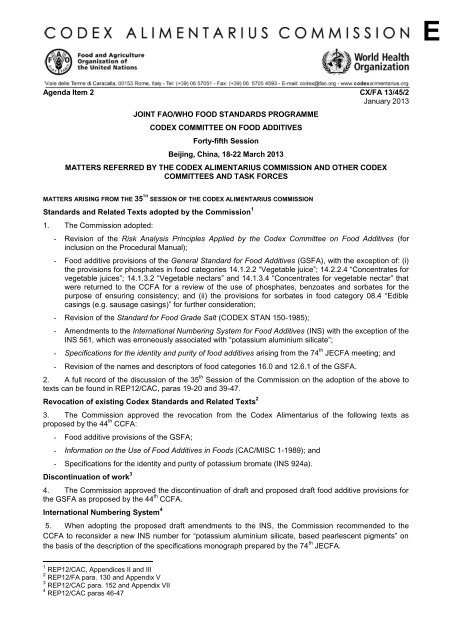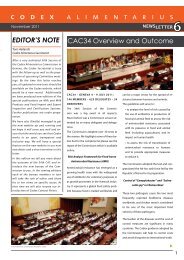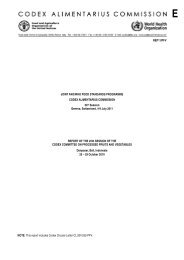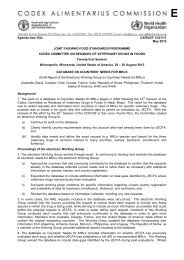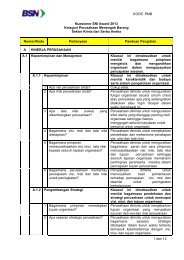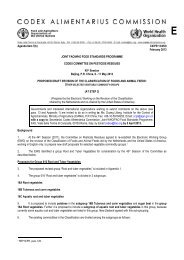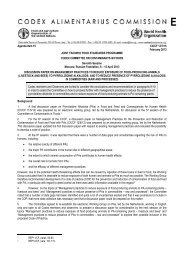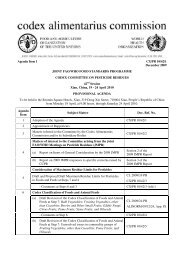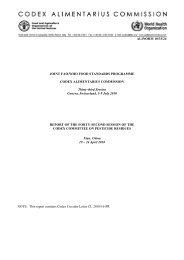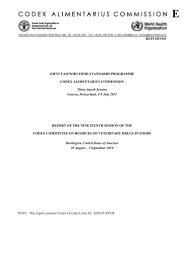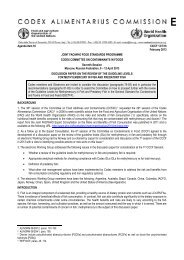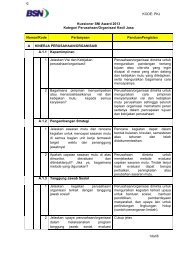CX/FA 13/45/2 - FAO.org
CX/FA 13/45/2 - FAO.org
CX/FA 13/45/2 - FAO.org
You also want an ePaper? Increase the reach of your titles
YUMPU automatically turns print PDFs into web optimized ePapers that Google loves.
E<br />
Agenda Item 2 <strong>CX</strong>/<strong>FA</strong> <strong>13</strong>/<strong>45</strong>/2<br />
January 20<strong>13</strong><br />
JOINT <strong>FA</strong>O/WHO FOOD STANDARDS PROGRAMME<br />
CODEX COMMITTEE ON FOOD ADDITIVES<br />
Forty-fifth Session<br />
Beijing, China, 18-22 March 20<strong>13</strong><br />
MATTERS REFERRED BY THE CODEX ALIMENTARIUS COMMISSION AND OTHER CODEX<br />
COMMITTEES AND TASK FORCES<br />
MATTERS ARISING FROM THE 35 TH SESSION OF THE CODEX ALIMENTARIUS COMMISSION<br />
Standards and Related Texts adopted by the Commission 1<br />
1. The Commission adopted:<br />
- Revision of the Risk Analysis Principles Applied by the Codex Committee on Food Additives (for<br />
inclusion on the Procedural Manual);<br />
- Food additive provisions of the General Standard for Food Additives (GS<strong>FA</strong>), with the exception of: (i)<br />
the provisions for phosphates in food categories 14.1.2.2 “Vegetable juice”; 14.2.2.4 “Concentrates for<br />
vegetable juices”; 14.1.3.2 “Vegetable nectars” and 14.1.3.4 “Concentrates for vegetable nectar” that<br />
were returned to the CC<strong>FA</strong> for a review of the use of phosphates, benzoates and sorbates for the<br />
purpose of ensuring consistency; and (ii) the provisions for sorbates in food category 08.4 “Edible<br />
casings (e.g. sausage casings)” for further consideration;<br />
- Revision of the Standard for Food Grade Salt (CODEX STAN 150-1985);<br />
- Amendments to the International Numbering System for Food Additives (INS) with the exception of the<br />
INS 561, which was erroneously associated with “potassium aluminium silicate”;<br />
- Specifications for the identity and purity of food additives arising from the 74 th JEC<strong>FA</strong> meeting; and<br />
- Revision of the names and descriptors of food categories 16.0 and 12.6.1 of the GS<strong>FA</strong>.<br />
2. A full record of the discussion of the 35 th Session of the Commission on the adoption of the above to<br />
texts can be found in REP12/CAC, paras 19-20 and 39-47.<br />
Revocation of existing Codex Standards and Related Texts 2<br />
3. The Commission approved the revocation from the Codex Alimentarius of the following texts as<br />
proposed by the 44 th CC<strong>FA</strong>:<br />
- Food additive provisions of the GS<strong>FA</strong>;<br />
- Information on the Use of Food Additives in Foods (CAC/MISC 1-1989); and<br />
- Specifications for the identity and purity of potassium bromate (INS 924a).<br />
Discontinuation of work 3<br />
4. The Commission approved the discontinuation of draft and proposed draft food additive provisions for<br />
the GS<strong>FA</strong> as proposed by the 44 th CC<strong>FA</strong>.<br />
International Numbering System 4<br />
5. When adopting the proposed draft amendments to the INS, the Commission recommended to the<br />
CC<strong>FA</strong> to reconsider a new INS number for “potassium aluminium silicate, based pearlescent pigments” on<br />
the basis of the description of the specifications monograph prepared by the 74 th JEC<strong>FA</strong>.<br />
1 REP12/CAC, Appendices II and III<br />
2 REP12/<strong>FA</strong> para. <strong>13</strong>0 and Appendix V<br />
3 REP12/CAC para. 152 and Appendix VII<br />
4 REP12/CAC paras 46-47
<strong>CX</strong>/<strong>FA</strong> <strong>13</strong>/<strong>45</strong>/2 2<br />
6. The Committee is invited to consider the above request concerning potassium aluminium silicate,<br />
based pearlescent pigments.<br />
MATTERS ARISING FROM OTHER COMMITTEES AND TASK FORCES<br />
32 nd Session of the Codex Committee on Fish and Fishery Products (CCFFP)<br />
(Bali, Indonesia, 1-5 October 2012) 5<br />
Inclusion of “carrier” as a functional class associated with dextrin, roasted starch (INS 1400)<br />
7. The CCFFP agreed to insert the carrier dextrin, roasted starch (INS 1400), with a note “carryover from<br />
flavouring substances” to clarify that it is linked with flavouring substances and a similar amendment was<br />
made for the emulsifier for polyoxyethylene (20) sorbitan monooleate (INS 433) included in the list. As<br />
currently “carrier” is not recognised as a functional class for dextrin, roasted starch (INS 1400), the CCFFP<br />
agreed to ask the CC<strong>FA</strong> to consider the inclusion of “carrier” as a functional class for this additive in the<br />
Class Names and the International Numbering System for Food Additives (CAC/GL 36-1989).<br />
8. The Committee is invited to consider the request concerning dextrin under Agenda Item 6<br />
“Proposals for Changes and/or Addition to the International Numbering System for Food Additives”.<br />
Inclusion of footnotes in food category 09.2.5 of the GS<strong>FA</strong><br />
9. The CCFFP noted that the following additives intended in the GS<strong>FA</strong> for other products in food<br />
category 09.2.5 in the applicable functional classes are not technologically justified for the specific foods<br />
covered in the draft standard for Smoked Fish, Smoke-Flavoured Fish and Smoke-Dried Fish, as follows:<br />
Antioxidants: propyl gallate (INS 310) and sulfites (INS 220-225, 227, 228, 539).<br />
Colours: canthaxanthin (INS 161g), caramel III – ammonia caramel (INS 150c), caramel IV (For use in<br />
surimi and fish roe products only) (INS 150d), carmines (INS 120), carotenoids (for use in surimi and<br />
fish roe products only) (INS 160a(i),a(iii),e,f), beta-carotenes, vegetable (INS 160a(ii)), chlorophylls<br />
and chlorophyllins, copper complexes (INS 141(i),(ii)), fast green FCF (INS 143), grape skin extract<br />
(INS 163(ii)), indigotine (Indigo carmines) (INS <strong>13</strong>2), iron oxides (INS 172(i)-(iii)), ponceau 4R<br />
(cochineal red A) (INS 124), riboflavines (INS 101(i),(ii)).<br />
Preservatives: butylated hydroxyanisole (BHA) (INS 320), butylated hydroxytoluene (BHT) (INS 321),<br />
sulfites (INS 220-225, 227, 228, 539).<br />
Flavour enhancers or Sweetener: acesulfame potassium (for use in sweet and sour products only)<br />
(INS 950), aspartame (For use in sweet and sour products only) (INS 951).<br />
10. The CCFFP therefore agreed to propose to the CC<strong>FA</strong> to insert a note to these additives to specify that<br />
they were not allowed in the products covered by the present standard, within category 09.2.5.<br />
11. The Committee is invited to consider the above request.<br />
26 th Session of the Committee on Processed Fruits and Vegetables (CCPFV)<br />
(Montego Bay, Jamaica 15-19 October 2012) 6<br />
12. The 26 th Session of the CCPFV considered the recommendations of the electronic Working Group<br />
(EWG) on food additives provisions for standards for processed fruits and vegetables already adopted or<br />
under development with a view to establishing a general reference to the GS<strong>FA</strong> when feasible and to provide<br />
justification in light of section 3 of the Preamble of the GS<strong>FA</strong> for exceptions to the general reference if/when<br />
such reference was not appropriate as follows:<br />
Standard for Table Olives (CODEX STAN 66-1981)<br />
<strong>13</strong>. The CCPFV agreed to make a general reference to the GS<strong>FA</strong> (see Agenda Item 4a).<br />
14. In addition, the following was brought to the attention of the CC<strong>FA</strong>:<br />
Regarding the food additive provisions in the step procedure for inclusion in the food category 04.2.2.3<br />
“vegetables (including mushrooms and fungi, roots and tubers, pulses and legumes, and aloe vera),<br />
seaweeds, and nuts and seeds”, the CCPFV noted that the EWG had not received any specific<br />
comments for adipates (INS 355-357, 359), sodium diacetate (INS 262(ii)), aluminium ammonium<br />
sulphate (INS INS 523) and propylene glycol alginate (INS 405). Therefore, the CCPVF agreed with<br />
5 REP<strong>13</strong>/FFP, paras <strong>13</strong>, 34 and 37-38<br />
6 REP<strong>13</strong>/PFV, paras. 35, 102-124, 141-149
<strong>CX</strong>/<strong>FA</strong> <strong>13</strong>/<strong>45</strong>/2 3<br />
the recommendation of the EWG that no technological need could be identified for these additives in<br />
table olives and to inform the CC<strong>FA</strong> accordingly.<br />
The CCPFV agreed to request the CC<strong>FA</strong> to classify calcium lactate (INS 327) and potassium chloride<br />
(INS 508) as firming agents in the food category 04.2.2.3 of the GS<strong>FA</strong>.<br />
Standard for Desiccated Coconut (CODEX STAN 177-1991)<br />
15. The CCPFV agreed that no changes would be made in the food additive provisions of the Standard.<br />
Standard for Certain Canned Citrus Fruits (CODEX STAN 254-2007)<br />
16. The CCPFV agreed to make a general reference to the GS<strong>FA</strong> to replace the current food additive<br />
provisions of the Standard (see Agenda Item 4a).<br />
17. In addition, the following was brought to the attention of the CC<strong>FA</strong>:<br />
Regarding the food additive provisions in the step procedure for inclusion in the food category 04.1.2.4<br />
“canned or bottled (pasteurized) fruit”, the CCPFV noted that the EWG had not received any specific<br />
comments for sodium diacetate (INS 262(ii)) and tartrates (INS 334, 335(i)(ii), 336(i)(ii), 337).<br />
Therefore, the CCPFV agreed with the recommendation of the EWG that no technological need could<br />
be identified for these additives in canned fruits and to inform the CC<strong>FA</strong> accordingly.<br />
The CCPFV agreed to request the CC<strong>FA</strong> to classify calcium lactate (INS 327) as a firming agent in the<br />
food category 04.1.2.4 of the GS<strong>FA</strong>.<br />
Standard for Preserved Tomatoes (CODEX STAN <strong>13</strong>-1981)<br />
18. The CCPFV agreed to update the provisions for acidity regulators while noting that it was not possible<br />
to make a general reference to the GS<strong>FA</strong> as only a limited number of acidity regulators were technologically<br />
justified for this product. The CCPFV further agreed to replace the list of firming agents by a general<br />
reference to Table 3 of the GS<strong>FA</strong> (see Agenda Item 4a).<br />
19. In addition, the following was brought to the attention of the CC<strong>FA</strong>:<br />
Regarding the food additive provisions in the step procedure for inclusion in the food category 04.2.2.4<br />
“canned or bottled (pasteurized) or retort pouch vegetables (including mushrooms and fungi, roots and<br />
tubers, pulses and legumes, and aloe vera) and seaweeds”, the CCPFV noted that the EWG had not<br />
received any specific comments for sodium diacetate (INS 262(ii)) and tartrates (INS 334, 335(i)(ii),<br />
336(i)(ii), 337). Therefore, the CCPFV agreed with the recommendation of the working group that no<br />
technological need was identified for these additives for preserved tomatoes and to inform the CC<strong>FA</strong><br />
accordingly.<br />
Standard for Processed Tomato Concentrates (CODEX STAN 57-1981)<br />
20. The CCPFV agreed to update the list of acidity regulators while noting that it was not possible to make<br />
a general reference to the GS<strong>FA</strong> as only a limited number of acidity regulators were technologically justified<br />
for this product (see Agenda Item 4a).<br />
Standard for Pickled Fruits and Vegetables (CODEX STAN 260-2007)<br />
21. The CCPFV noted that it needed to have more information and adequate time to review food additive<br />
provisions for pickled fruits and vegetables and requested the Codex Secretariat to issue a circular letter<br />
soliciting comments on the proposal for a general reference to the GS<strong>FA</strong>.<br />
22. The 26 th Session of the CCPFV also considered other matters related to food additive provisions as<br />
follows:<br />
As regards the request of the 43 rd session of the CC<strong>FA</strong> on the use of other tartrates as acidity<br />
regulators in canned bamboo shoots including the appropriate report basis and the use of<br />
other colours and flavour enhancers in canned mushrooms as listed in the food category<br />
04.2.2.4 of the GS<strong>FA</strong>, the CCPFV agreed to inform the CC<strong>FA</strong> that these matters would be further<br />
considered at its 27 th session to be held in the second half of 2014.<br />
23. As regards food additive provisions for water-based flavoured drinks, the CCPFV agreed to<br />
request the CC<strong>FA</strong> whether water-based flavoured drinks were adequately covered by the food categories in<br />
the GS<strong>FA</strong> and if not whether the appropriate food categories could be expanded to include these products. If<br />
the food categories, 14.1.4.2 “Non-carbonated water-based flavoured drinks, including punches and ades”<br />
and 14.1.4.3 “Concentrates (liquid or solid) for water-based flavoured drinks” did cover these water-based<br />
flavoured drinks, to determine whether there was a need to expand the list of food additives e.g., to include<br />
flavour enhancers, preservatives, acidity regulators and colours.
<strong>CX</strong>/<strong>FA</strong> <strong>13</strong>/<strong>45</strong>/2 4<br />
24. As per the above discussion, the Committee is invited to:<br />
Note the decision of the CCPFV on food additive provisions in the Standard for Desiccated Coconut;<br />
the continuous work on food additive provisions in the Standard for Pickled Fruits and Vegetables with<br />
a view to a general reference to the GS<strong>FA</strong>; and the further work on the use of other tartrates as acidity<br />
regulators in the Standard for Canned Bamboo Shoots and on the use of other colours and flavour<br />
enhancers in the Annex on Mushrooms of the Standard for Certain Canned Vegetables.<br />
Note that provisions for food additives in the Standards for Table Olives, Certain Canned Citrus Fruits,<br />
Preserved Tomatoes and Processed Tomato Concentrates will be considered under Agenda Item 4(a)<br />
“Endorsement and/or Revision of Maximum Levels for Food Additives and Processing Aids in Codex<br />
Standards;<br />
Consider the CCPFV’s request concerning addition functional classes associated with calcium lactate<br />
(INS 327) and potassium chloride (INS 508) under Agenda Item 6 “Proposals for Changes and/or<br />
Addition to the International Numbering System for Food Additives”.<br />
Consider the CCPFV’s advice concerning the technological need for certain food additives in the<br />
GS<strong>FA</strong> food categories 04.2.2.3, 04.1.2.4 and 04.2.2.4, as indicated above in points regarding the<br />
standards for table olives, certain canned citrus fruits and preserved tomatoes;<br />
Consider the CCPFV’s request on food additive provisions for water-based flavoured drinks.<br />
25. A full extract of the CCPFV relevant discussion is presented in Annex 1 to facilitate the consideration<br />
of the above matters.<br />
18 th Session of the <strong>FA</strong>O/WHO Coordinating Committee for Latin America and the Caribbean (CCLAC)<br />
(San José, Costa Rica, 19-23 November 2012) 7<br />
Use of Note 161 in the GS<strong>FA</strong><br />
26. The CCLAC agreed to recommend to the CC<strong>FA</strong> to (a) evaluate on a case-by-case basis all uses of<br />
note 161 and to set a time limit for its elimination from the GS<strong>FA</strong> and (b) not use such note any longer in the<br />
development of new maximum level in the GS<strong>FA</strong>. A full extract of the CCLAC discussion on Note 161 is<br />
presented in Annex 2.<br />
27. The Committee is invited to note the CCLAC recommendation when considering Agenda Item 9(b)<br />
“Discussion paper on Recommendations for Note 161 of the GS<strong>FA</strong>”.<br />
OTHERS<br />
28. When updating the GS<strong>FA</strong> to reflect the decision of the 36 th Session of the Commission, it has been<br />
noted that for sixteen (16) food additives included in the GS<strong>FA</strong> there is no corresponding specifications. An<br />
analysis, prepared by the JEC<strong>FA</strong> Secretariat, of the status of the JEC<strong>FA</strong> evaluation for these substances is<br />
presented in Table 1.<br />
29. The analysis has shown that:<br />
a) Five (Table 3 food additives) have ADI not specified/not limited (five), namely: ammonium acetate (INS<br />
264), ammonium lactate (INS 328), potassium ascorbate (INS 303), potassium hydrogen malate (INS<br />
351(i)) and potassium malate (INS 351(ii));<br />
b) Seven (Table 1 and 2 food additives) have a group ADI, namely sodium adipates (INS 356),<br />
potassium adipates (INS 357), ammonium adipates (INS 359), monosodium tartrate (INS 335(i)),<br />
monopotassium tartrate (INS 336(i)), dipotassium tartrate (INS 336(ii)) and potassium bisulfite (INS<br />
228).<br />
c) Propane (INS 944), no specifications was prepared (the 23 rd JEC<strong>FA</strong> decided that it was not necessary<br />
to establish an ADI)<br />
30. For the remaining three food additives:<br />
d) Chlorine dioxide (INS 926), the specifications was withdrawn;<br />
e) Choline salts and esters (INS 1001), only exists a specification for choline chloride as a flavouring<br />
agent;<br />
f) Formic acid (INS 236), only exists a specification as a flavouring agent;<br />
7 REP<strong>13</strong>/LAC, paras <strong>13</strong>6-141
<strong>CX</strong>/<strong>FA</strong> <strong>13</strong>/<strong>45</strong>/2 5<br />
31. In order to deal with the situation and keep in the GS<strong>FA</strong> only the food additives for which specifications<br />
have been developed by JEC<strong>FA</strong> and adopted by Codex the following two-step process is recommended:<br />
Issue a Circular Letter requesting information on the commercial use of the additives listed under (a)<br />
(b) and (c) and for the commercial use and technological justification of choline salts and esters (d).<br />
Based on the information provided, the next CC<strong>FA</strong> will recommend to remove from the GS<strong>FA</strong> all food<br />
additives for which information on their commercial use has not been provided and will include in the<br />
priority list for JEC<strong>FA</strong> the others with the understanding that countries should make a firm commitment<br />
to provide data for drafting the specifications to JEC<strong>FA</strong> by the 47 th CC<strong>FA</strong> (pending the commitment the<br />
food additive will be removed).<br />
32. For the remaining substance it is recommended that the CC<strong>FA</strong>:<br />
Chlorine dioxide (INS 926)<br />
First consider whether is a food additive or a processing aid and include it in the Circular Letter above<br />
in case it is considered a food additive.<br />
Formic acid (INS 236)<br />
Ask JEC<strong>FA</strong> Secretariat to clarify why the food additives specification was withdrawn.<br />
33. The Committee is invited to consider the above recommendations.
<strong>CX</strong>/<strong>FA</strong> <strong>13</strong>/<strong>45</strong>/2 6<br />
Table 1 – Review of the status of the JEC<strong>FA</strong> evaluation<br />
Additive INS GS<strong>FA</strong><br />
Table 1<br />
Ammonium<br />
acetate<br />
Ammonium<br />
lactate<br />
GS<strong>FA</strong><br />
Table 3<br />
Codex<br />
specs<br />
264 No Yes No 26 th Meeting: ADI not<br />
specified<br />
JEC<strong>FA</strong> evaluation JEC<strong>FA</strong> specs Possible action<br />
26 th Meeting: not prepared • Ask for commercial use<br />
• If yes, JEC<strong>FA</strong> priority form to be submitted<br />
for drafting specifications<br />
328 No Yes No 17 th Meeting: ADI not limited 17 th Meeting: not prepared • Ask for commercial use<br />
• If yes, JEC<strong>FA</strong> priority form to be submitted<br />
for drafting specifications<br />
Chlorine dioxide 926 Yes (1<br />
adopted)<br />
Choline salts and<br />
esters<br />
No No 7 th Meeting: acceptable for<br />
flour treatment<br />
1001 No Yes No 15 th Meeting: ADI not limited<br />
73 rd Meeting: choline chloride<br />
as a flavouring<br />
Formic acid 236 Yes (2<br />
adopted)<br />
Potassium<br />
ascorbate<br />
Potassium<br />
bisulfite<br />
303 Yes (5<br />
adopted,<br />
many in<br />
step<br />
process)<br />
No<br />
Flavourin<br />
g (!)<br />
17 th Meeting: ADI 0 – 3 mg/kg<br />
bw<br />
55 th Meeting: flavouring use<br />
acceptable, ADI maintained<br />
Yes No 17 th Meeting: group ADI 0-15<br />
mg/kg bw<br />
25 th Meeting: group ADI not<br />
specified<br />
228 Yes No No 51 st Meeting: group ADI of 0-<br />
0.7 mg/kg bw to sulfur dioxide<br />
and to sulfur dioxide<br />
equivalents (including<br />
Potassium hydrogen sulfite)<br />
7 th Meeting: prepared<br />
FNP 52/1: tentative<br />
55 th Meeting: withdrawn, no<br />
reply to call for data<br />
15 th Meeting: not prepared<br />
73 rd Meeting: choline chloride<br />
as a flavouring<br />
17 th Meeting: prepared<br />
FNP 52/1: full specification<br />
as preservative, flavour adjunt<br />
55 th Meeting: revised due to<br />
flavouring use, re-evaluation<br />
at future meeting needed<br />
17 th Meeting: not prepared<br />
25 th Meeting: not prepared<br />
51 st Meeting: No information<br />
was made available … no<br />
specifications were prepared<br />
• Discussion whether food additive or<br />
processing aid <br />
• If additive, JEC<strong>FA</strong> priority form to be<br />
submitted for re-evaluation in view of new<br />
toxicological data<br />
• Ask for commercial use, technological<br />
justification<br />
• If yes, JEC<strong>FA</strong> priority form to be submitted<br />
for drafting specifications, possibly also reevaluation<br />
()<br />
• Ask JEC<strong>FA</strong> Secretariat for clarification why<br />
for additive specifications were withdrawn<br />
[could be a mistake]<br />
• Ask for commercial use<br />
• If yes, JEC<strong>FA</strong> priority form to be submitted<br />
for drafting specifications<br />
• Ask for commercial use<br />
• If yes, JEC<strong>FA</strong> priority form to be submitted<br />
for drafting specifications
<strong>CX</strong>/<strong>FA</strong> <strong>13</strong>/<strong>45</strong>/2 7<br />
Additive INS GS<strong>FA</strong><br />
Table 1<br />
Potassium<br />
malate<br />
GS<strong>FA</strong><br />
Table 3<br />
Codex<br />
specs<br />
351ii No Yes No 23 rd Meeting: group ADI not<br />
specified<br />
JEC<strong>FA</strong> evaluation JEC<strong>FA</strong> specs Possible action<br />
22 nd Meeting: prepared<br />
tentative specifications (for<br />
Potassium DL-Malate<br />
solution)<br />
23 rd Meeting: revised<br />
tentative specifications<br />
30 th Meeting: Withdrawn, no<br />
use reported<br />
• Ask for commercial use<br />
• If yes, JEC<strong>FA</strong> priority form to be submitted<br />
for drafting specifications<br />
rd Propane 944 No Yes No 23 rd Meeting: ADI not<br />
specified 8 23 Meeting: not prepared • Ask CC<strong>FA</strong> for their view whether based on<br />
JEC<strong>FA</strong> this is still an acceptable Table 3<br />
additive<br />
• If yes, JEC<strong>FA</strong> priority form to be submitted<br />
for drafting specifications, possibly also reevaluation<br />
()<br />
• If no, remove<br />
Sodium adipates 356 No 21 st Meeting: group ADI not<br />
specified<br />
Potassium<br />
adipates<br />
Ammonium<br />
adipates<br />
Monosodium<br />
tartrate<br />
Monopotassium<br />
tartrate<br />
Dipotassium<br />
tartrate<br />
357 No 21 st Meeting: group ADI not<br />
specified<br />
359 No 21 st Meeting: group ADI not<br />
specified<br />
335(i) for 335(ii) 21 st Meeting: group ADI of 0-<br />
30 mg/kg bw<br />
336(i) for 337 21 st Meeting: group ADI of 0-<br />
30 mg/kg bw<br />
336(ii) for 337 21 st Meeting: group ADI of 0-<br />
30 mg/kg bw<br />
21 st Meeting: not prepared • Ask for commercial use<br />
• If yes, JEC<strong>FA</strong> priority form to be submitted<br />
for drafting specifications<br />
21 st Meeting: not prepared • Ask for commercial use<br />
• If yes, JEC<strong>FA</strong> priority form to be submitted<br />
for drafting specifications<br />
21 st Meeting: not prepared • Ask for commercial use<br />
• If yes, JEC<strong>FA</strong> priority form to be submitted<br />
for drafting specifications<br />
21 st Meeting: specifications<br />
exist, not revised (p 37)<br />
• Ask for commercial use<br />
• If yes, JEC<strong>FA</strong> priority form to be submitted<br />
for drafting specifications<br />
21 st Meeting: not prepared • Ask for commercial use<br />
• If yes, JEC<strong>FA</strong> priority form to be submitted<br />
for drafting specifications<br />
21 st Meeting: not prepared • Ask for commercial use<br />
• If yes, JEC<strong>FA</strong> priority form to be submitted<br />
for drafting specifications<br />
8 Propane : Owing to the limited use and limited residues in food of this compound the Committee decided it was not necessary to establish an ADI. No toxicological monograph or<br />
specifications were prepared. (TRS 648 / p 23).
<strong>CX</strong>/<strong>FA</strong> <strong>13</strong>/<strong>45</strong>/2 8<br />
Extracts of the CCPFV discussion on the food additive provisions for processed fruits and<br />
vegetables: additional provisions for inclusion in selected adopted standards and standards<br />
under development<br />
(REP<strong>13</strong>/PFV, paras 102-118)<br />
Annex 1<br />
102. The Committee recalled that at its 25 th Session it had requested the electronic Working Group on Food<br />
Additives, chaired by the European Union and co-chaired by the United States of America, to look into the<br />
food additive provisions associated with table olives and certain canned fruits and selected standards for<br />
processed fruits and vegetables i.e., desiccated coconut, preserved tomatoes, processed tomato<br />
concentrates, certain canned citrus fruits and pickled fruits and vegetables within the framework of the<br />
General Standard for Food Additives with a view to establishing a general reference to the GS<strong>FA</strong> when<br />
feasible and to provide justification in light of section 3 of the Preamble of the GS<strong>FA</strong> for exceptions to the<br />
general reference if/when such reference was not appropriate.<br />
103. The Delegation of the European Union reported to the Committee on the analysis, conclusions and<br />
recommendations of the working group (<strong>CX</strong>/PFV 12/26/7).<br />
104. The Committee considered the recommendations from the working group and made the following<br />
comments and decisions:<br />
Desiccated Coconut:<br />
105. The Committee agreed that no changes would be made in the food additive provisions of the Standard<br />
for Desiccated Coconut (CODEX STAN 177-1991).<br />
Table Olives:<br />
106. The Committee noted that the recommendations for food additive provisions of the Standard for Table<br />
Olives had already been included when the Committee considered the revision of this Standard (see<br />
paragraph 35).<br />
107. Regarding the food additive provisions in the step procedure for inclusion in the food category 04.2.2.3<br />
(vegetables (including mushrooms and fungi, roots and tubers, pulses and legumes, and aloe vera),<br />
seaweeds, and nuts and seeds), the Committee noted that the EWG had not received any specific<br />
comments for adipates, sodium diacetate, aluminium ammonium sulphate and propylene glycol alginate and<br />
therefore the Committee agreed with the recommendation of the working group that no technological need<br />
could be identified for these additives in table olives and to inform Committee on Food Additives accordingly.<br />
108. The Committee also agreed to request the CC<strong>FA</strong> to classify calcium lactate (INS 327) and potassium<br />
chloride (INS 508) as firming agents in the food category 04.2.2.3 of the GS<strong>FA</strong>.<br />
Certain Canned Citrus Fruits:<br />
109. A general reference to the GS<strong>FA</strong> should be inserted in section 4 of the Standard for Certain Canned<br />
Citrus Fruits (CODEX STAN 254-2007) to replace the current food additive provisions of the Standard.<br />
110. Regarding the food additive provisions in the step procedure for inclusion in the food category 04.1.2.4<br />
(canned or bottled (pasteurized) fruit), the Committee noted that the EWG had not received any specific<br />
comments for sodium diacetate and tartrates, and therefore the Committee agreed with the recommendation<br />
of the working group that no technological need could be identified for these additives in canned fruits and to<br />
inform the CC<strong>FA</strong> accordingly.<br />
111. The Committee agreed to also request the CC<strong>FA</strong> to classify calcium lactate as a firming agent in the<br />
food category 04.1.2.4 of the GS<strong>FA</strong>.<br />
Preserved Tomatoes:<br />
112. The Committee agreed to update the provisions for acidity regulators of the Standard for Preserved<br />
Tomatoes (CODEX STAN <strong>13</strong>-1981) as recommended by the working group. The Committee noted that it<br />
was not possible to make a general reference to the GS<strong>FA</strong> as only a limited number of acidity regulators<br />
were technologically justified for this product. The Committee further agreed to replace the list of firming<br />
agents by a general reference to Table 3 of the GS<strong>FA</strong>.
<strong>CX</strong>/<strong>FA</strong> <strong>13</strong>/<strong>45</strong>/2 9<br />
1<strong>13</strong>. Regarding the food additive provisions in the step procedure for inclusion in the food category 04.2.2.4<br />
(canned or bottled (pasteurized) or retort pouch vegetables (including mushrooms and fungi, roots and<br />
tubers, pulses and legumes, and aloe vera) and seaweeds), the Committee noted that the EWG had not<br />
received any specific comments for sodium diacetate and tartrates and therefore the Committee agreed with<br />
the recommendation of the working group that no technological need was identified for these additives for<br />
preserved tomatoes and to inform the CC<strong>FA</strong> accordingly.<br />
Processed Tomato Concentrates:<br />
114. The Committee agreed to update the list of acidity regulators of the Standard for Processed Tomato<br />
Concentrates (CODEX STAN 57-1981) as recommended by the working group. The Committee noted that it<br />
was not possible to make a general reference to the GS<strong>FA</strong> as only a limited number of acidity regulators<br />
were technologically justified for this product and agreed to inform the CC<strong>FA</strong> accordingly.<br />
Pickled Fruits and Vegetables:<br />
115. Regarding the use of a general reference to the GS<strong>FA</strong> in the Standard for Pickled Fruits and<br />
Vegetables (CODEX STAN 260-2007), the Delegation of the European Union expressed concern as<br />
although this approach was recommended in the Procedural Manual, it could be problematic because<br />
pickled fruits and vegetables fell under several food categories in the GS<strong>FA</strong>, resulting in a very long list of<br />
food additives allowed for this commodity. The Delegation pointed out that it would therefore be in conflict<br />
with the provision in section 3.2 of the Preamble of the GS<strong>FA</strong> stating that food additives should be used only<br />
when needed.<br />
116. The Committee noted that it needed to have more information and adequate time to review this matter<br />
and requested the Codex Secretariat to issue a circular letter soliciting comments on the proposal for a<br />
general reference to the GS<strong>FA</strong>.<br />
117. The Delegation of the United States of America expressed concern with continuing this time- and<br />
resource-consuming effort and was of the opinion that the recommendations should be accepted and sent to<br />
the CC<strong>FA</strong> for endorsement. The Delegation further noted that the working group had recommended the<br />
removal of some food additives as not being technologically justified based on the fact that no comments<br />
had been received, which was not appropriate, as members and/or observers might simply not have<br />
commented even though food additives were used and were technologically justified.<br />
118. The Delegation of the EU reiterated its general concern with regard to a direct reference to the GS<strong>FA</strong>.<br />
The Delegation of Brazil also expressed its concern with a general reference, in particular to the use of<br />
colours.<br />
(REP<strong>13</strong>/PFV, paras 141-149)<br />
Extracts of the CCPFV discussion on the development of a standard for<br />
Flavoured Water-based Drinks<br />
141. The Delegation of Kenya introduced the discussion paper and explained that water-based flavoured<br />
drinks were usually concentrates that were diluted before consumption or sold ready-to-drink, were noncarbonated<br />
and manufactured and sold globally in both developed and developing countries. The<br />
predominant ingredients were water, colours, sugar and flavour enhancers; and the colours and flavour<br />
enhancers used, were either synthetic or natural extracts from fruits and vegetables.<br />
142. The Delegation noted that these formulated non-carbonated drinks did not quite fall under the food<br />
categories 14.1.4 water-based flavoured drinks, including “sports”, “energy” or “electrolytes” drinks and<br />
particulated drinks, 14.1.4.2 carbonated water-based flavoured drinks, including punches and ades which<br />
were based on fruits and vegetables, and 14.1.4.3 for concentrates (liquid and solid) for water-based<br />
flavoured drinks of the General Standard for Food Additives.<br />
143. Noting that the Committee on Processed Fruits and Vegetables was not the committee to address<br />
this matter and that the main concern was the unsafe or unregulated use of certain food additives, such as<br />
flavour enhancers, colours and preservatives, the Delegation requested the support of the Committee for<br />
work on safe use of food additives in water-based flavoured drinks in the GS<strong>FA</strong> and to recommend the<br />
Commission to request the Committee on Food Additives to consider the expansion of the food categories<br />
mentioned above, and to further develop the list of food additives under those food categories of the GS<strong>FA</strong><br />
to cover these products. In doing so, it would ensure transparency and harmonisation of standards that<br />
would assist in particular those developing countries which did not have provisions in this respect in their<br />
legislation.
<strong>CX</strong>/<strong>FA</strong> <strong>13</strong>/<strong>45</strong>/2 10<br />
144. The Delegation also noted that labelling was sufficiently addressed in the General Standard for the<br />
Labelling of Pre-packaged Foods (CODEX STAN 1-1989), and flavourings through several other standards,<br />
including the Guidelines for the Use of Flavourings (CAC/GL 66-2008).<br />
1<strong>45</strong>. Several delegations understood or supported the concerns expressed by Kenya and supported the<br />
proposal that the Committee request the CC<strong>FA</strong> to consider the matter. Some of these delegations also<br />
suggested that this matter be brought to the attention of Committee on Food Labelling. A delegation further<br />
noted that acidity regulators should also be included in the list of additives to be addressed.<br />
146. An Observer pointed out that concentrates for water-based flavoured drinks were included in the food<br />
category 14.1.4.3 and if the food additives of concern were not specifically addressed in this food category,<br />
those food additives in the broader category, 14.1.4, would also apply, due to the hierarchical nature of the<br />
GS<strong>FA</strong>.<br />
147. With regard to the concerns with specific food additives, the Observer noted that there were<br />
procedures in Codex to raise these concerns whether related to labelling or additives or flavourings.<br />
148. In addition, it was noted that the GS<strong>FA</strong> was built to address functional classes across food categories<br />
and that there was a priority process for addressing food additives in the General Standard. Currently there<br />
were two circular letters requesting proposals for new additive provisions or revision of additive provisions<br />
(CL 2012/5-<strong>FA</strong>) and for proposals for additions or changes to the priority list of food additives proposed for<br />
evaluation by JEC<strong>FA</strong> (CL 2012/8-<strong>FA</strong>).<br />
149. Acknowledging the importance of the concerns raised by Kenya, the Committee agreed to request<br />
the CC<strong>FA</strong> to consider whether water-based flavoured drinks were adequately covered by the food categories<br />
in the GS<strong>FA</strong> and if not whether the appropriate food categories could be expanded to include these<br />
products. If the food categories, 14.1.4.2 to 14.1.4.3 did cover these water-based flavoured drinks, to<br />
determine whether there was a need to expand the list of food additives e.g., to include flavour enhancers,<br />
preservatives, acidity regulators and colours.
<strong>CX</strong>/<strong>FA</strong> <strong>13</strong>/<strong>45</strong>/2 11<br />
(REP<strong>13</strong>/LAC, paras <strong>13</strong>6-141)<br />
Use of note 161 in the GS<strong>FA</strong><br />
Extracts of the CCLAC on the use of Note 161 in the GS<strong>FA</strong><br />
Annex 2<br />
<strong>13</strong>6. The Chairperson recalled that the CCLAC had already taken a position on this matter at its last<br />
session as noted in paragraph 141 of the Report of the 17th Session of the Committee (REP11/LAC).<br />
<strong>13</strong>7. The Committee noted that while the discussion on this matter had been suspended at the 44th<br />
Session of the CC<strong>FA</strong>, it has been re-introduced in the agenda of its <strong>45</strong>th Session to be held in March 20<strong>13</strong> in<br />
Beijing, China.<br />
<strong>13</strong>8. The Committee noted also that the note 161 had not been used since its last session but the concern<br />
remained with the existing notes which allowed countries to define their own maximum levels.<br />
<strong>13</strong>9. A delegation noted that the existence of the note reflects a lack of consensus concerning certain<br />
maximum limits often related to sweeteners and colours. The delegation suggested that all maximum levels<br />
for which the note had been introduced should be reviewed on a case-by-case basis with the objective to<br />
gradually eliminate the use of the note.<br />
140. Some delegations did not favour to examine all MLs in the General Standard for Food Additives on a<br />
case-by-case basis as this would take too much time. If the elimination of the note was done on a case-bycase<br />
basis, a time limit should be given to complete the process. It was noted that, as the CC<strong>FA</strong> agenda is<br />
very busy it would be best to leave the setting of such a time limit to the CC<strong>FA</strong>.<br />
Conclusion<br />
141. The Committee agreed to recommend to the CC<strong>FA</strong> to (a) evaluate on a case-by-case basis all uses of<br />
note 161 and to set a time limit for its elimination from the GS<strong>FA</strong> and (b). not use such note any longer in the<br />
development of new maximum level in the GS<strong>FA</strong>.


